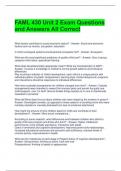FAML 430 Unit 2 Exam Questions
and Answers All Correct
What factors contribute to social economic status? - Answer- Social and economic
factors such as income, occupation, education
In which ecological systems would parental occupation fall? - Answer- Exosystem
What are the most significant predictors of quality child care? - Answer- Size of group,
caregiver-child ratios, specialized training
What does developmentally appropriate mean? What are characteristics of DAP? -
Answer- Involves a knowledge of children's normal growth patterns and individual
differences
Play is primary indicator of child's development, each child is a unique person with
individual pattern of growth, temperament, learning style, family background, programs
and interactions should be responsive to individual differences
How have custodial arrangements for children changed over time? - Answer- Custody
arrangements were intended to reward the innocent party and punish the guilty one
(child support), now "no-fault" divorce divides things equally so no one is intentionally
rewarded or punished
What did Rene Spitz find out about children who were raised by the mothers in prison? -
Answer- Developed normally, as opposed to those raised in a foundling home who were
mentally retarded or mentally disturbed from lack of emotional attachment
How might the amount of time children spend in child care contribute to their
development? - Answer- More social competence...
According to some research, what differences exist between children who attend a
quality child care program and those who don't? - Answer- Higher intellectual
performance, more verbally expressive, interactive with adults
Gains in emotional and cognitive development, improved parent-child relationships,
increased educational outcomes and economic self-sufficiency, reduced levels of
criminal activity, improvements in health
What are the milestones at each stage in Piaget's theory of cognitive development? -
Answer- Sensorimotor: thinking is action, here and now
Preoperational: thinking is based on appearance
, Concrete operational: thinking is based on reality
Formal operational: thinking is based on abstractions
What is the difference between cultural assimilation, a melting pot, and cultural
pluralism? - Answer- Cultural assimilation: process whereby a minority cultural group
takes on the characteristics of the majority cultural group
Melting pot: idea that society should socialize diverse groups to blend into a common
culture
Cultural pluralism: mutual appreciation and understanding of various cultures and
coexistence in society of different languages, religious beliefs, and lifestyles
What conditions increase the risk of child maltreatment? - Answer- Temperament,
marital distress, unemployment, lack of community support, cultural values, tolerance
for violence, view of child as property
What is the Economic Opportunity act of 1964? - Answer- An Act to mobilize the human
and financial resources of the Nation to combat poverty in the United States
Why are their funding inequalities among schools? - Answer- Education policies are
under state jurisdiction, differences in property taxes
What is an individualized education plan (IEP)? What are basic characteristics? -
Answer- IEP: a form of communication between school and family developed by a
group of people (teacher, parent, other involved persons) responsible for the education
of a child with special needs
States child's level of educational performance, annual goals and objectives, specific
special education services, evaluation procedures, schedules for meeting objectives
Students with disabilities must be places in the least restrictive environment
What are characteristics of teacher directed and child centered approaches to
education? - Answer- Teacher: behaviorist (direct instruction curriculum), don't wait for
kids to be ready, content and sequence determined by teacher, structured detailed and
sequential
Child: based on individual needs, stage of development, child-initiated activities
What is the Montessori approach to education? - Answer- (Learner-directed) Based on
individual self-directed learning with the teacher as the facilitator, materials provide
exercises in daily living, sensory development, and academic development
How are interactions between children and caregivers different in affluent areas? -
Answer- More sophisticated language, caregivers ignore crying, invite action (clean up),
controlled child's time and space and objects, gave firm direction, compliance and
conformity and performance curriculum
When did public schooling become available to all children? - Answer- after the civil war




